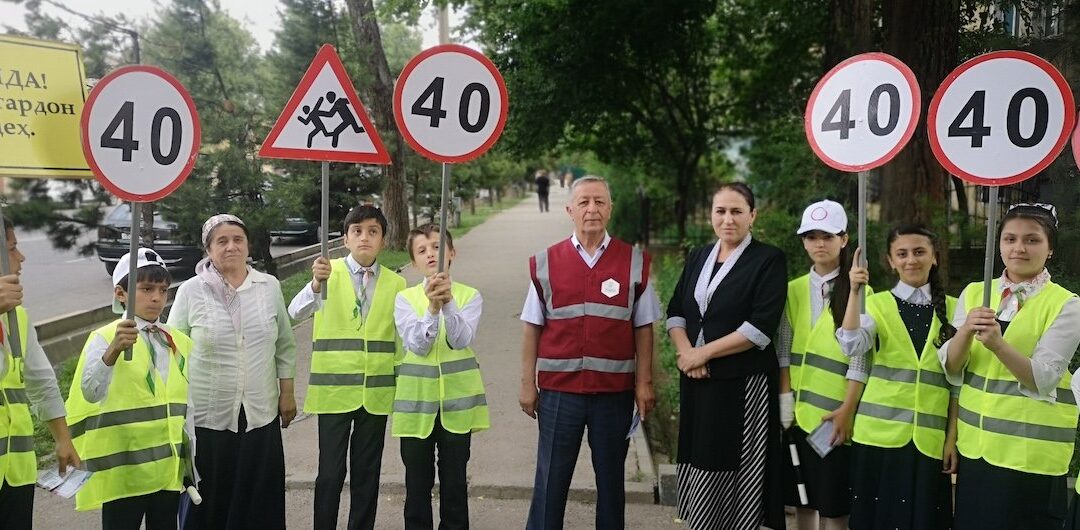Crédito da imagem: EASST
O aplicativo Star Rating for Schools foi usado para ajudar a avaliar e melhorar a segurança no trânsito nas escolas do Tadjiquistão.
Em 2021, a Polícia Rodoviária do Tajiquistão relatou 85 mortes de crianças e 260 feridos devido a acidentes de trânsito. Cinquenta por cento dos acidentes no total envolveram pedestres e a velocidade foi registrada como um fator em mais de 65% de incidentes. A segurança rodoviária das crianças no Tajiquistão precisa de ser abordada com urgência.
Com parceiro local Geração Jovem do Tajiquistão (YGT), a Aliança Oriental para Transportes Seguros e Sustentáveis vem trabalhando com o apoio do Centro de Advocacia do FIA Foundation abordar esta questão.
A EASST tem trabalhado com escolas na capital Dushanbe para reduzir as velocidades e melhorar a infraestrutura para tornar as viagens para a escola mais seguras para cerca de 10.000 crianças.
Três escolas piloto foram selecionadas com base no elevado número de vítimas registadas em áreas próximas. Trabalhando com a Polícia Rodoviária, a YGT decidiu realizar medições de velocidade e avaliar a infraestrutura de segurança das zonas escolares usando o Kit de ferramentas de avaliação da zona escolar EASST e o aplicativo Classificação por estrelas para escolas.
Em cada escola, a YGT estabeleceu um Comité de “Zona Escolar Segura” envolvendo membros da liderança escolar, pais, professores, alunos e representantes da Polícia Rodoviária. Juntos, os comités analisaram os resultados das avaliações e desenvolveram um conjunto de recomendações para melhorar a situação.
Todas as três escolas estão localizadas perto de rodovias com várias faixas. O limite de velocidade nas duas escolas foi fixado em 60 km/h e embora a terceira escola tivesse um limite de velocidade de 40 km/h, as velocidades operacionais medidas pela YGT e pela Polícia Rodoviária em Abril de 2022 registaram uma média de 53 km/h.
A partir de junho de 2022, a YGT e o Ministério da Administração Interna começaram a implementar mudanças. Em primeiro lugar, os limites de velocidade em torno das duas escolas foram reduzidos de 60 km/h para 40 km/h – a velocidade actualmente recomendada para zonas escolares no Tajiquistão.
Foram instalados novos sinais de trânsito de alta visibilidade em cada escola, informando os condutores sobre os limites de velocidade e que estão a entrar numa zona escolar, e as passadeiras foram repintadas com tinta de alta visibilidade.
Na escola número 4, faixas de ruído foram adicionadas à estrada para incentivar os motoristas a reduzir a velocidade, enquanto um semáforo existente (mas quebrado) para pedestres foi consertado na escola número 1.
Na escola número 28, foram acrescentadas coberturas às valas de drenagem nas laterais da estrada para tornar o pavimento acessível a pessoas que utilizam cadeiras de rodas, bicicletas e carrinhos de bebé, bem como para evitar que os peões tenham de saltar para a estrada.
Estas pequenas intervenções foram de baixo custo e fizeram uma diferença significativa, mas é urgentemente necessário mais trabalho para tornar as estradas em Dushanbe seguras para todos.
Em Outubro, a YGT organizou uma reunião de Diálogo Político com representantes da Polícia Rodoviária, engenheiros rodoviários da Universidade Técnica do Tajiquistão e outras organizações da sociedade civil. Durante a reunião, a YGT apresentou os resultados do seu trabalho em torno das três escolas de Dushanbe e apelou a que mais fosse feito a nível municipal, incluindo a redução dos limites de velocidade recomendados em torno das escolas para 30 km/h.
A Polícia Rodoviária concordou, em princípio, com a ideia de reduzir os limites de velocidade de acordo com as normas internacionais, mas primeiro solicitou mais provas através de esquemas piloto locais. Concordaram também em atribuir um representante do seu departamento para actuar como consultor permanente da YGT sobre questões de segurança rodoviária, abordando em particular a necessidade de mudanças semelhantes nas infra-estruturas a serem implementadas em mais escolas e jardins de infância na cidade.
Este é um importante passo em frente para resolver a crise de segurança rodoviária no Tajiquistão. À medida que avançamos para 2023, procuraremos trabalhar ainda mais neste aspecto para garantir ruas mais seguras para as crianças irem e voltarem da escola.

